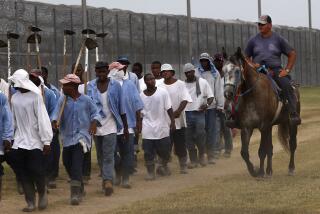The Slow Rot at Supermax
ALEXANDRIA, Va. — Halfway through the trial, prison expert James E. Aiken looked straight at jurors and told them what Zacarias Moussaoui could expect if they sent him away for the rest of his life.
“I have seen them rot,” he said. “They rot.”
Aiken was describing what happens to the nation’s highest-risk prisoners after they settle in at the federal government’s maximum-security prison in Florence, Colo., known as Supermax.
Moussaoui was formally sentenced Thursday to life in prison after a federal jury rejected a death sentence for the admitted Sept. 11 conspirator.
Officials at the Federal Bureau of Prisons said that Moussaoui was destined for the facility high in the Colorado Rockies.
Already there is a veritable “bombers’ row” -- Ramzi Ahmed Yousef, mastermind of the 1993 World Trade Center blast; Unabomber Theodore Kaczynski; Terry L. Nichols, an accomplice in the Oklahoma City bombing; Richard Reid, the so-called shoe bomber who Moussaoui testified was to join him in another Al Qaeda hijacking; and Eric Rudolph, who bombed abortion clinics and the Atlanta Olympics.
All, like Moussaoui, are serving life without parole -- spending their days in prison wings that are partly underground. They exist alone in soundproof cells as small as 7 feet by 12 feet, with a concrete-poured desk, bed and stool, a small shower and sink, and a TV that offers religious and anger-management programs.
They are locked down 23 hours a day.
Larry Homenick, a former U.S. marshal who has taken prisoners to Supermax, said that there was a small triangular recreation area, known as “the dog run,” where solitary Supermax prisoners could occasionally get a glimpse of sky.
He said it was chilling to walk down the cellblocks and glance through the plexiglass “sally port” chambers into the cells and see the faces inside.
Life there is harsh. Food is delivered through a slit in the cell door. Prisoners don’t leave their cells to see a lawyer, a doctor or a prison official; those visitors must go to the cell.
But prisoners can earn extra privileges, like a wider variety of television offerings, more exercise time and visitation rights, based on their behavior.
There are 1,400 remote-controlled steel doors. Motion detectors and hidden cameras monitor every move. The prison walls and razor-wired grounds are patrolled by laser beams and dogs.
The facility is filling up. Four hundred inmates are there now. There is room for 90 more.
Looking to restore order after a rash of prison violence at the federal maximum-security lockup in Marion, Ill. -- the facility that replaced the notorious Alcatraz prison in San Francisco Bay -- officials in 1983 put the prisoners on indefinite lockdown.
California was among the first states to copy the concept, opening super-secure units in Corcoran in 1988 and Pelican Bay in 1989.
The federal Supermax prison in Colorado was opened in November 1994. Nobody has escaped.
“We just needed a more secure facility,” said Tracy Billingsley, a spokeswoman for the Federal Bureau of Prisons. “We needed to bring together the most dangerous, that required the most intense supervision, to one location.”
In his trial testimony, Aiken said the whole point of Supermax was not just punishment, but “incapacitation.”
There is no pretense that the prison is preparing the inmate for a return to society. Like the cellmate of the count of Monte Cristo who died an old, tired convict, Aiken said, “Moussaoui will deteriorate.”
The inmate “is constantly monitored 24 hours a day, seven days a week,” he said. “He will never get lost in a crowd because he would never be in a crowd.”
Christopher Boyce, a convicted spy who was incarcerated at Supermax, left the prison about 100 miles south of Denver with no regret. “You’re slowly hung,” he once told The Times. “You’re ground down. You can barely keep your sanity.”
Bernard Kleinman, a New York lawyer who represented Yousef, called it “extraordinarily draconian punishment.”
Moussaoui might be a household name today, “but 20 years from now, people will forget him,” Kleinman said. “He will sit there all alone, and all forgotten.”
Ron Kuby, another New York defense lawyer, has handled several East Coast “revolutionaries” who went on a killing spree, and a radical fundamentalist who killed a rabbi in 1990. All were brought to Supermax.
He thought Aiken’s description that prisoners rot inside its walls was too kind.
“It’s beyond rotting,” he said. “Rotting at least implies a slow, gradual disintegration.”
He said there were a lot of prisons where inmates rot, where the staff “plants you in front of your TV in your cell and you just grow there like a mushroom.”
“But Supermax is worse,” he said. “It’s not just the hothouse for the mushrooms. It’s designed in the end to break you down.”
More to Read
Sign up for Essential California
The most important California stories and recommendations in your inbox every morning.
You may occasionally receive promotional content from the Los Angeles Times.











